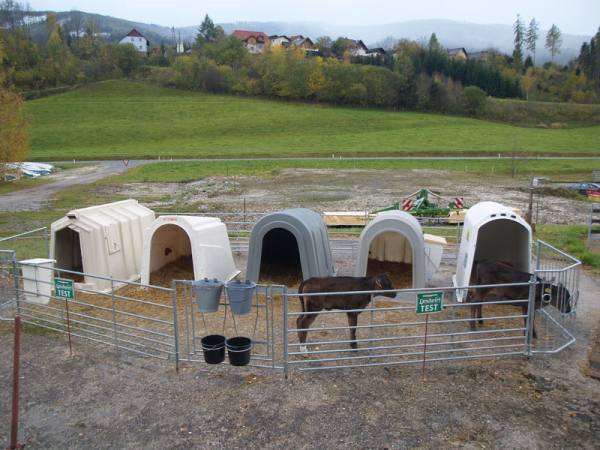Goal
In addition to user-friendliness, the animal-friendliness of the system should also be examined. For this purpose, parameters are collected that are suitable for adequately assessing the health and well-being of the animal. In addition to measuring the temperature and humidity in the igloo, the internal body and surface temperatures as well as the heart and breathing rates of the calves are also measured. Since there are significant structural differences between the individual huts, a total of five different makes are tested. In addition to assessing the health, behavior of the breeding calves and user-friendliness, special attention is also paid to the quality of the execution of the various huts and of course also to the price/performance ratio. The results of the study provide conclusions about the animal-friendliness of the system or the individual huts and can subsequently be used as a basis for discussion. After they are published immediately, they are available to farmers as a valuable decision-making aid when planning and possibly redesigning the stable, especially the calf area.
introduction
From 2006 onwards, compliance with the regulations on calf husbandry will be checked by the AMA control bodies as part of the control of the cross-compliance provisions. In addition to the ban on tethered housing and mandatory group housing from 8 weeks onwards, the stable climate and lighting conditions are also checked. Failure to comply with these regulations will result in premium reductions and, in extreme cases, the loss of funding. For this reason, many farmers are forced to re-adapt the stables for raising calves or to look for other alternatives.
The easiest way to meet this requirement is to keep the calves in calf igloos. This form of husbandry has proven particularly useful for small populations or when no construction work can be carried out. A calf igloo is a shelter for calves, which can also be used for foals and other animals of comparable size. It is usually made of glass fiber reinforced plastic and is open to the bottom and to one side. There is a metal grille on the open side that limits the outlet. The floor of the calf igloo is strewn with straw. These igloos are usually placed outside under the eaves or under a canopy, but they can also be completely outdoors. The calves therefore have the best air and light conditions around the clock. They can be outside whenever they want and still not be exposed to cold winds and other weather influences. If it's too windy/sunny/rainy/... they can retreat into the igloo. In order to achieve this protective effect, the opening of the calf igloo must not face the weather side.
The calves are brought into the huts immediately after birth, but at the latest after their fur has dried, and can be kept there individually until they are 8 weeks old. The huts should be set up so that the calves can at least make eye contact. Keeping calves in outdoor climate conditions has proven to be particularly effective when it comes to health problems in the stable. However, the prerequisite for this is sufficient cleaning or disinfection before each new occupancy, as well as a sufficiently thick straw mattress as insulation from the subsoil and good care intensity on the part of the farmer.
Igloos are therefore an optimal housing system for calves. For example, FRERKING et al. (1975), SCHULZE HOCKENBECK (1980), HANCOCK (1983) and SVENSSON et al. (2003) found that diarrheal illnesses are more severe in calves kept in groups than in individual boxes. It is ideal to keep calves in an area where they have no contact with older conspecifics (FINK, 1980; SCHULZE HOCKENBECK, 1980; RADEMACHER, 2000). FRERKING et al. (1975), RADEMACHER (2000) and BIEWER (2001) claim that the individual box and the calf igloo are the most suitable housing options for the first weeks of life, although the igloo is even better than the individual box. The fresh air, sufficient light and stronger environmental stimuli contribute significantly to the health, vitality and well-being of the calves.
In contrast, animal welfare is often very skeptical about keeping calves in calf igloos. It is claimed that the ban on individual housing is being circumvented and it is also overlooked that larger calves are kept in group igloos. It is unbearable that even in organic farming, animals kept individually have to endure extra organic animal cruelty in extreme cold or heat in "free-range" conditions (Dr. Friedrich Landa, animal protection umbrella organization).
Experimental plan
After the producer companies claim that the huts hardly heat up in the summer and that in Austria only the test results of the individual companies are available, the LFZ Raumberg - Gumpenstein over a period of approx. 3 months (June - August 2007) together with the The trade magazine “The Progressive Farmer” carried out a comparative study on the heat suitability of individual calf huts (calf igloos).
For this purpose, the huts of the various companies will be set up parallel to each other, each facing north. The installation site is outdoors and is neither protected from the wind nor shaded.
The calves come into these igloos immediately after birth and stay there until they are 5 weeks old (35 days of life). The calves are then kept in group housing with the other animals. Each igloo is then cleaned and disinfected and occupied again. After the second period, which lasts another 5 weeks, a choice experiment is carried out over a period of 2 weeks. For this purpose, the fences in front of the igloos are connected so that a common run is created for all the huts. This unit is then occupied with two new calves and the lying behavior of the two animals is recorded and evaluated using video.
In order to prevent feeding influences, all calves are fed a standardized diet, i.e. all calves receive exactly the same amount of feed.
Feeding schedule
|
Week |
Whole milk kg / day |
Concentrated feed kg / day |
hay kg / day |
|
1 2 3 4 5 |
Biestmilch 4 - 5 6 7 7 8 |
- 0,125 0,25 0,375 0,5 |
- Free recording " " " |
In addition, clean drinking water is offered from the first week of life.
The following parameters are examined:
- Visual assessment and technical processing (recording the dimensions)
- User-friendliness : for feeding, drinking, removing manure (stable and run), changing stables and cleaning; Recording the time spent on feeding and cleaning, determining individual straw requirements;
- Feed intake surveys : the amount of water and concentrated feed is rationed (all animals are the same); Hay and water are offered for free consumption;
- Weighings and records: animal weights weekly; stool consistency daily; internal body temperature 2 x per day (7:00 a.m. and 4:00 p.m.); all abnormalities and illnesses including treatments;
- Animal health parameters and animal behavior:
Pulse frequency (Art. coccxgea med), internal body temperature, surface temperature (infrared thermometer), breathing frequency, thermography (thermal imaging camera), weight gain, drinking and eating behavior (video observation)
Frequency of surveys in 2-hour intervals starting at 6:00 a.m
Dates - Time: 6:00
8:00
10:00
12:00
14:00
16:00
18:00







